Analys
Donald D-Day in the oil market

 As always it is very difficult to know what Donald Trump is going to do: Reinstate sanctions or not? And today at 2 pm Washington time (5 pm CET) we will know. European diplomats (UK, France, Germany) who have discussed the Iran issues with US negotiators this spring seems to be convinced that Donald will exit the deal today and thus revive the US Iran sanctions from 2012. Trump reiterated on Monday his view that it is a “very badly negotiated deal” sowing little optimism for staying with the deal.
As always it is very difficult to know what Donald Trump is going to do: Reinstate sanctions or not? And today at 2 pm Washington time (5 pm CET) we will know. European diplomats (UK, France, Germany) who have discussed the Iran issues with US negotiators this spring seems to be convinced that Donald will exit the deal today and thus revive the US Iran sanctions from 2012. Trump reiterated on Monday his view that it is a “very badly negotiated deal” sowing little optimism for staying with the deal.
In February 2018 when Donald threatened to exit the deal last time there seemed to be very little understanding among the European allies what Trump really wanted to change in the Iran deal. Versus that there now seems to be quite some progress. Now it seems that there is a general agreement and understanding that the current deal is far from good enough and that it needs to be improved. We’ll see later today whether this is good enough for him to waive the sanctions yet again, kick the can down the road for another 180 days, lowering the gasoline pump prices and pleasing his consumers and mid-term election voters. If sanctions are revived then the impact is likely going to be limited for the 2018 oil market balance. Towards the end of 2019 however Iran’s crude oil exports could be reduced towards 1.3 m bl/d versus an average of 2.1 m bl/d in 2017. Reduced investments would hamper future Iranian production growth.
It seems clear that Donald Trump’s push towards the nuclear deal has opened the eyes of the European allies with the acceptance that the deal needs to be amended and improved. The key points which need to be amended, improved, added or addressed are:
- Iran’s missile program
- Iran’s meddling with other nations in the region like the current proxy war with Saudi Arabia in Yemen. In general curbing any Iranian effort for Iranian based Shia Muslim dominance in the Middle East
- Sunset clauses in the current Iran nuclear deal which currently allows Iran to resume uranium enrichment after 2025 with possible revival of its nuclear program
- Financing of terrorism
Iran however has stated that the current nuclear deal struck 14 July 2015 the Joint Comprehensive Plan of Action (JCPOA) is non-negotiable. That stand could be a red flag for Donald Trump making him push harder.
One can speculate whether the US mid-term elections might play a part in his decision today. What will be most important for the US voters: 1) Nixing the Iran nuclear deal + high gasoline prices or 2) A strong Donald Trump pushing the parties to the negotiation table + lower gasoline prices? It is clear that higher oil prices and retail US gasoline prices are eroding some of the positives from Donald’s tax cuts thus creating an economic headwind for the US consumers. Whether such considerations are part of his deliberations over the Iran nuclear deal decision today at 2 pm Washington time remains to be seen. He has at least already accused OPEC of manipulating the oil market to higher prices thus showing some sensitivity to the issue of higher oil and gasoline prices.
If Trump today reactivates the 2012 National Defence Authorization Act (NDAA) then importers of Iranian crude oil will need to seek exemptions to import crude oil or face US sanctions towards their state owned financial institutions or central banks. The once seeking exemptions in order to import crude oil from Iran will typically need to reduce imports by 20% every 180 days. China, Japan, South Korea and Japan would be the most important parties in terms of magnitude. Though China does not agree to new sanctions towards China it may still comply with the NDAA if it is revived in order to avoid secondary sanctions towards Chinese financial institutions from the US.
If all current importers of Iranian crude oil decide to ask for exemptions and thus continue to import Iranian crude they would still need to reduce imports by 20% every 180 days. Over the past 6 months Iran exported 2.1 m bl/d. A rolling 180 days 20% reduction would reduce Iranian exports to 1.3 m bl/d at the end of 2019 and close to 1 m bl/d in early 2020. It would have limited impact on the 2018 balance as it takes time to revive the sanctions. It would hamper investments in Iranian oil resources thus leading to a potentially tighter future oil market. This is probably why we have seen oil prices for longer dated contracts rise just as much as the front end of the crude oil curve lately.
The US sanctions towards Iran are multi-layered. The Iran Sanctions Act (ISA) from 1996, the Iran Threat Reduction and Syria Human Act (TRA) and the Iran Freedom and Counter proliferations Act (IFCA) from 2012 are up for their 180 days waiver renewal in July.
Kind regards
Bjarne Schieldrop
Chief analyst, Commodities
SEB Markets
Merchant Banking
Analys
More weakness and lower price levels ahead, but the world won’t drown in oil in 2026

Some rebound but not much. Brent crude rebounded 1.5% yesterday to $65.47/b. This morning it is inching 0.2% up to $65.6/b. The lowest close last week was on Thursday at $64.11/b.

The curve structure is almost as week as it was before the weekend. The rebound we now have gotten post the message from OPEC+ over the weekend is to a large degree a rebound along the curve rather than much strengthening at the front-end of the curve. That part of the curve structure is almost as weak as it was last Thursday.
We are still on a weakening path. The message from OPEC+ over the weekend was we are still on a weakening path with rising supply from the group. It is just not as rapidly weakening as was feared ahead of the weekend when a quota hike of 500 kb/d/mth for November was discussed.
The Brent curve is on its way to full contango with Brent dipping into the $50ies/b. Thus the ongoing weakening we have had in the crude curve since the start of the year, and especially since early June, will continue until the Brent crude oil forward curve is in full contango along with visibly rising US and OECD oil inventories. The front-month Brent contract will then flip down towards the $60/b-line and below into the $50ies/b.
At what point will OPEC+ turn to cuts? The big question then becomes: When will OPEC+ turn around to make some cuts? At what (price) point will they choose to stabilize the market? Because for sure they will. Higher oil inventories, some more shedding of drilling rigs in US shale and Brent into the 50ies somewhere is probably where the group will step in.
There is nothing we have seen from the group so far which indicates that they will close their eyes, let the world drown in oil and the oil price crash to $40/b or below.
The message from OPEC+ is also about balance and stability. The world won’t drown in oil in 2026. The message from the group as far as we manage to interpret it is twofold: 1) Taking back market share which requires a lower price for non-OPEC+ to back off a bit, and 2) Oil market stability and balance. It is not just about 1. Thus fretting about how we are all going to drown in oil in 2026 is totally off the mark by just focusing on point 1.
When to buy cal 2026? Before Christmas when Brent hits $55/b and before OPEC+ holds its last meeting of the year which is likely to be in early December.
Brent crude oil prices have rebounded a bit along the forward curve. Not much strengthening in the structure of the curve. The front-end backwardation is not much stronger today than on its weakest level so far this year which was on Thursday last week.
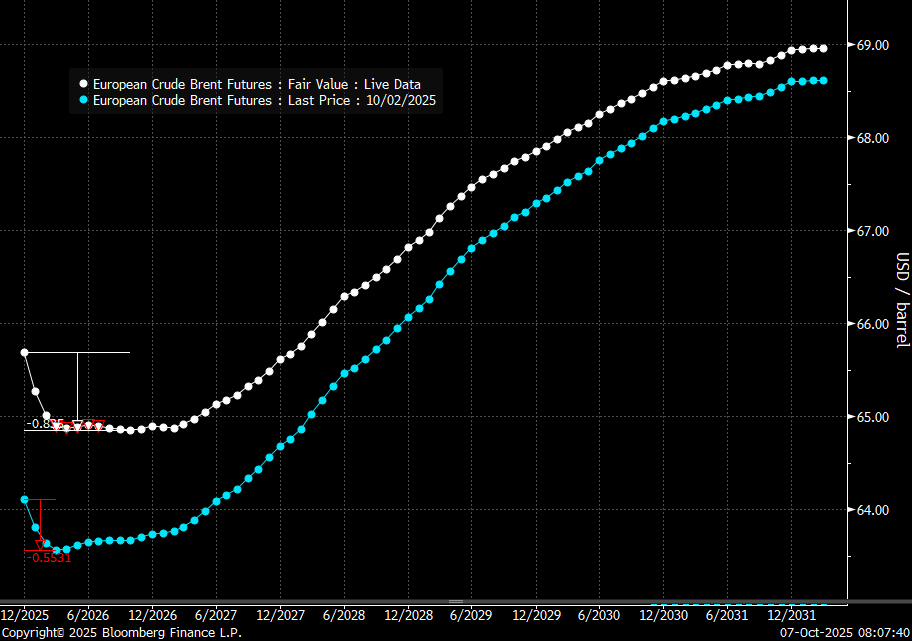
The front-end backwardation fell to its weakest level so far this year on Thursday last week. A slight pickup yesterday and today, but still very close to the weakest year to date. More oil from OPEC+ in the coming months and softer demand and rising inventories. We are heading for yet softer levels.
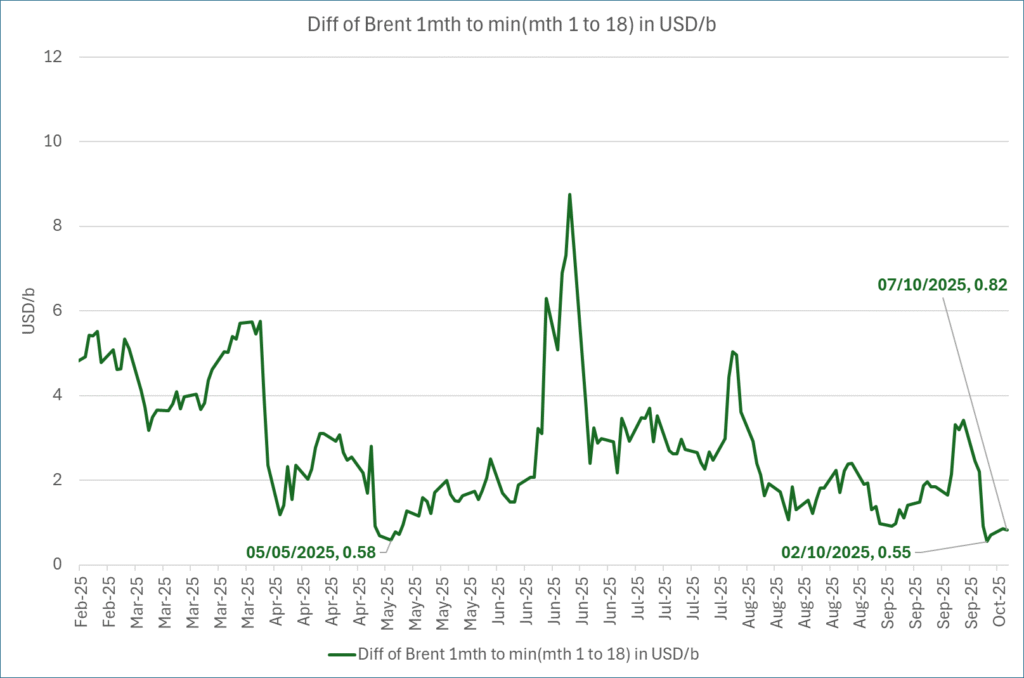
Analys
A sharp weakening at the core of the oil market: The Dubai curve

Down to the lowest since early May. Brent crude has fallen sharply the latest four days. It closed at USD 64.11/b yesterday which is the lowest since early May. It is staging a 1.3% rebound this morning along with gains in both equities and industrial metals with an added touch of support from a softer USD on top.

What stands out the most to us this week is the collapse in the Dubai one to three months time-spread.
Dubai is medium sour crude. OPEC+ is in general medium sour crude production. Asian refineries are predominantly designed to process medium sour crude. So Dubai is the real measure of the balance between OPEC+ holding back or not versus Asian oil demand for consumption and stock building.
A sharp weakening of the front-end of the Dubai curve. The front-end of the Dubai crude curve has been holding out very solidly throughout this summer while the front-end of the Brent and WTI curves have been steadily softening. But the strength in the Dubai curve in our view was carrying the crude oil market in general. A source of strength in the crude oil market. The core of the strength.
The now finally sharp decline of the front-end of the Dubai crude curve is thus a strong shift. Weakness in the Dubai crude marker is weakness in the core of the oil market. The core which has helped to hold the oil market elevated.
Facts supports the weakening. Add in facts of Iraq lifting production from Kurdistan through Turkey. Saudi Arabia lifting production to 10 mb/d in September (normal production level) and lifting exports as well as domestic demand for oil for power for air con is fading along with summer heat. Add also in counter seasonal rise in US crude and product stocks last week. US oil stocks usually decline by 1.3 mb/week this time of year. Last week they instead rose 6.4 mb/week (+7.2 mb if including SPR). Total US commercial oil stocks are now only 2.1 mb below the 2015-19 seasonal average. US oil stocks normally decline from now to Christmas. If they instead continue to rise, then it will be strongly counter seasonal rise and will create a very strong bearish pressure on oil prices.
Will OPEC+ lift its voluntary quotas by zero, 137 kb/d, 500 kb/d or 1.5 mb/d? On Sunday of course OPEC+ will decide on how much to unwind of the remaining 1.5 mb/d of voluntary quotas for November. Will it be 137 kb/d yet again as for October? Will it be 500 kb/d as was talked about earlier this week? Or will it be a full unwind in one go of 1.5 mb/d? We think most likely now it will be at least 500 kb/d and possibly a full unwind. We discussed this in a not earlier this week: ”500 kb/d of voluntary quotas in October. But a full unwind of 1.5 mb/d”
The strength in the front-end of the Dubai curve held out through summer while Brent and WTI curve structures weakened steadily. That core strength helped to keep flat crude oil prices elevated close to the 70-line. Now also the Dubai curve has given in.
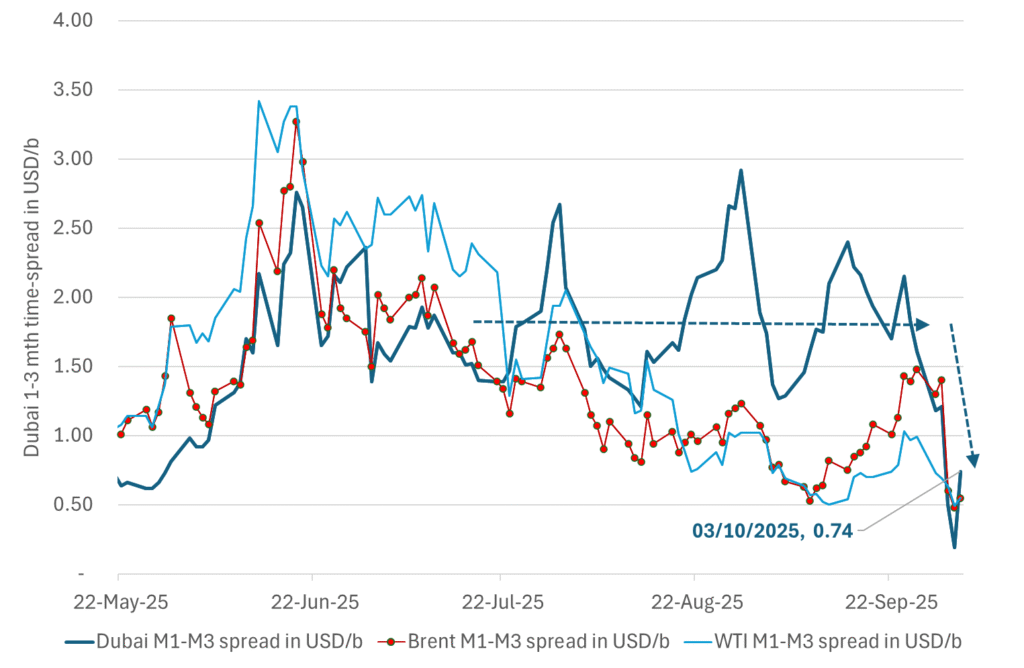
Brent crude oil forward curves
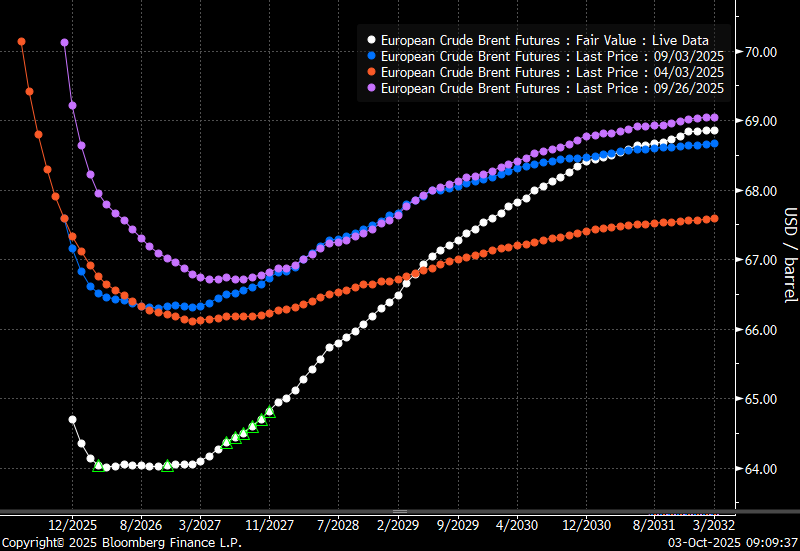
Total US commercial stocks now close to normal. Counter seasonal rise last week. Rest of year?
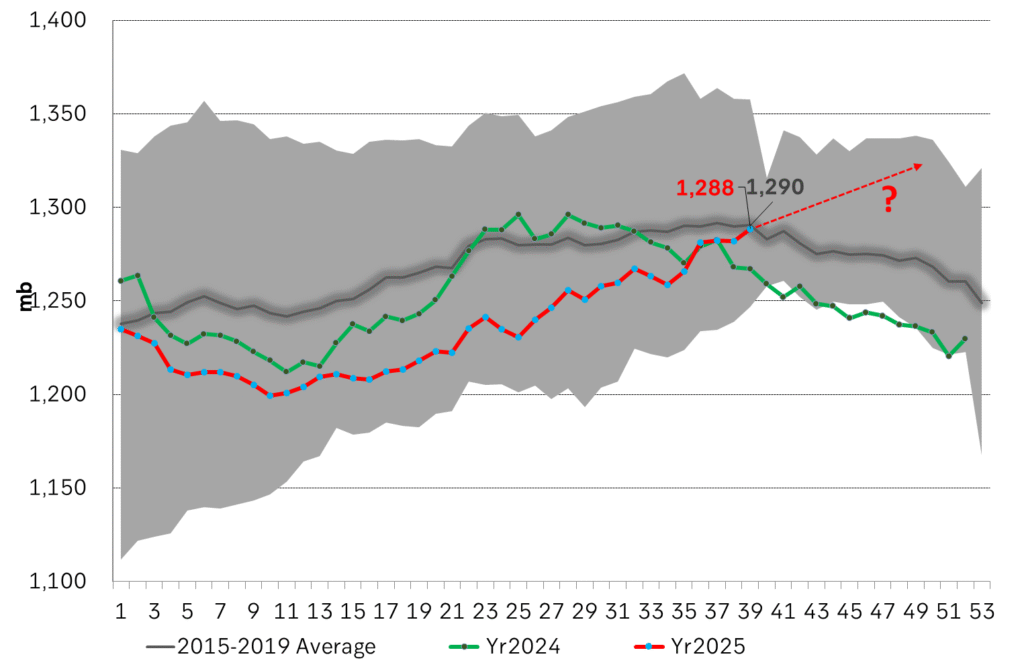
Total US crude and product stocks on a steady trend higher.
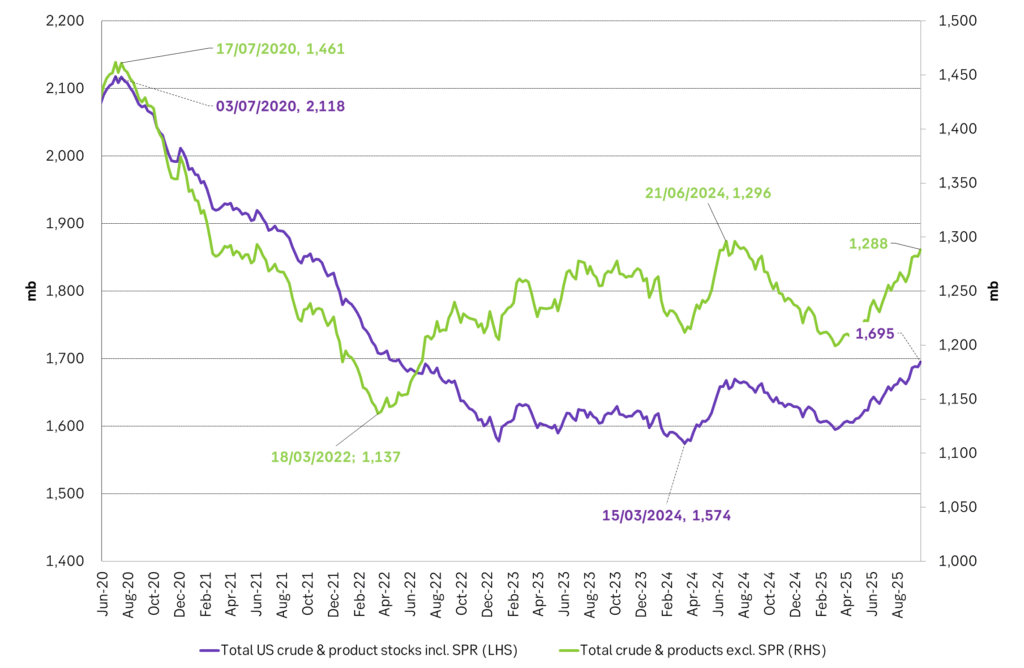
Analys
OPEC+ will likely unwind 500 kb/d of voluntary quotas in October. But a full unwind of 1.5 mb/d in one go could be in the cards

Down to mid-60ies as Iraq lifts production while Saudi may be tired of voluntary cut frugality. The Brent December contract dropped 1.6% yesterday to USD 66.03/b. This morning it is down another 0.3% to USD 65.8/b. The drop in the price came on the back of the combined news that Iraq has resumed 190 kb/d of production in Kurdistan with exports through Turkey while OPEC+ delegates send signals that the group will unwind the remaining 1.65 mb/d (less the 137 kb/d in October) of voluntary cuts at a pace of 500 kb/d per month pace.

Signals of accelerated unwind and Iraqi increase may be connected. Russia, Kazakhstan and Iraq were main offenders versus the voluntary quotas they had agreed to follow. Russia had a production ’debt’ (cumulative overproduction versus quota) of close to 90 mb in March this year while Kazakhstan had a ’debt’ of about 60 mb and the same for Iraq. This apparently made Saudi Arabia angry this spring. Why should Saudi Arabia hold back if the other voluntary cutters were just freeriding? Thus the sudden rapid unwinding of voluntary cuts. That is at least one angle of explanations for the accelerated unwinding.
If the offenders with production debts then refrained from lifting production as the voluntary cuts were rapidly unwinded, then they could ’pay back’ their ’debts’ as they would under-produce versus the new and steadily higher quotas.
Forget about Kazakhstan. Its production was just too far above the quotas with no hope that the country would hold back production due to cross-ownership of oil assets by international oil companies. But Russia and Iraq should be able to do it.
Iraqi cumulative overproduction versus quotas could reach 85-90 mb in October. Iraq has however steadily continued to overproduce by 3-5 mb per month. In July its new and gradually higher quota came close to equal with a cumulative overproduction of only 0.6 mb that month. In August again however its production had an overshoot of 100 kb/d or 3.1 mb for the month. Its cumulative production debt had then risen to close to 80 mb. We don’t know for September yet. But looking at October we now know that its production will likely average close to 4.5 mb/d due to the revival of 190 kb/d of production in Kurdistan. Its quota however will only be 4.24 mb/d. Its overproduction in October will thus likely be around 250 kb/d above its quota with its production debt rising another 7-8 mb to a total of close to 90 mb.
Again, why should Saudi Arabia be frugal while Iraq is freeriding. Better to get rid of the voluntary quotas as quickly as possible and then start all over with clean sheets.
Unwinding the remaining 1.513 mb/d in one go in October? If OPEC+ unwinds the remaining 1.513 mb/d of voluntary cuts in one big go in October, then Iraq’s quota will be around 4.4 mb/d for October versus its likely production of close to 4.5 mb/d for the coming month..
OPEC+ should thus unwind the remaining 1.513 mb/d (1.65 – 0.137 mb/d) in one go for October in order for the quota of Iraq to be able to keep track with Iraq’s actual production increase.
October 5 will show how it plays out. But a quota unwind of at least 500 kb/d for Oct seems likely. An overall increase of at least 500 kb/d in the voluntary quota for October looks likely. But it could be the whole 1.513 mb/d in one go. If the increase in the quota is ’only’ 500 kb/d then Iraqi cumulative production will still rise by 5.7 mb to a total of 85 mb in October.
Iraqi production debt versus quotas will likely rise by 5.7 mb in October if OPEC+ only lifts the overall quota by 500 kb/d in October. Here assuming historical production debt did not rise in September. That Iraq lifts its production by 190 kb/d in October to 4.47 mb/d (August level + 190 kb/d) and that OPEC+ unwinds 500 kb/d of the remining quotas in October when they decide on this on 5 October.
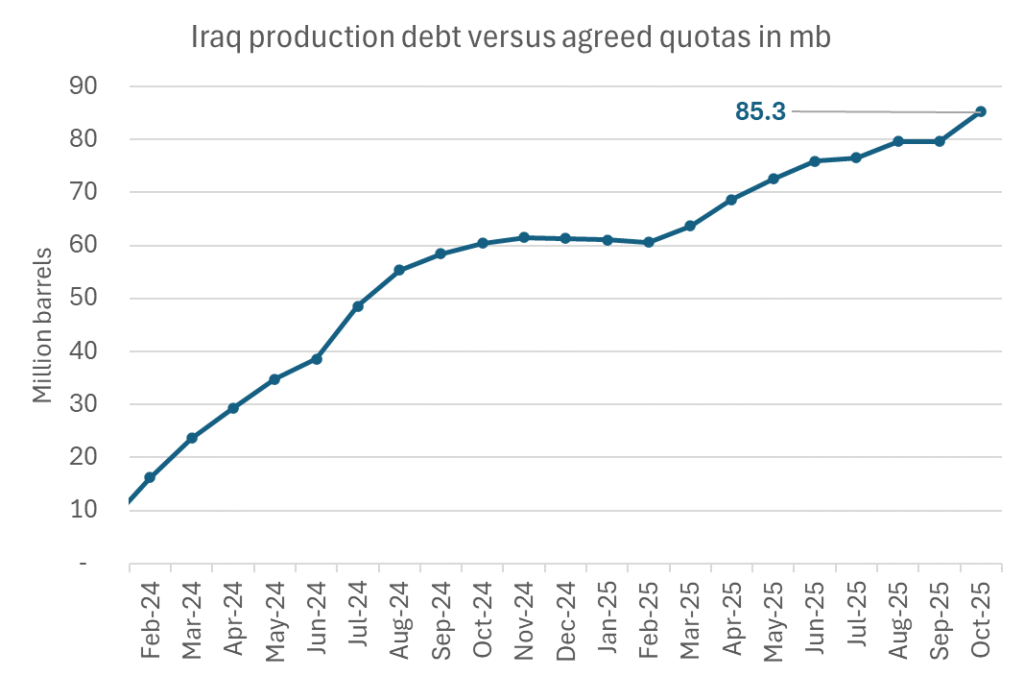
-

 Nyheter4 veckor sedan
Nyheter4 veckor sedanKinas elproduktion slog nytt rekord i augusti, vilket även kolkraft gjorde
-
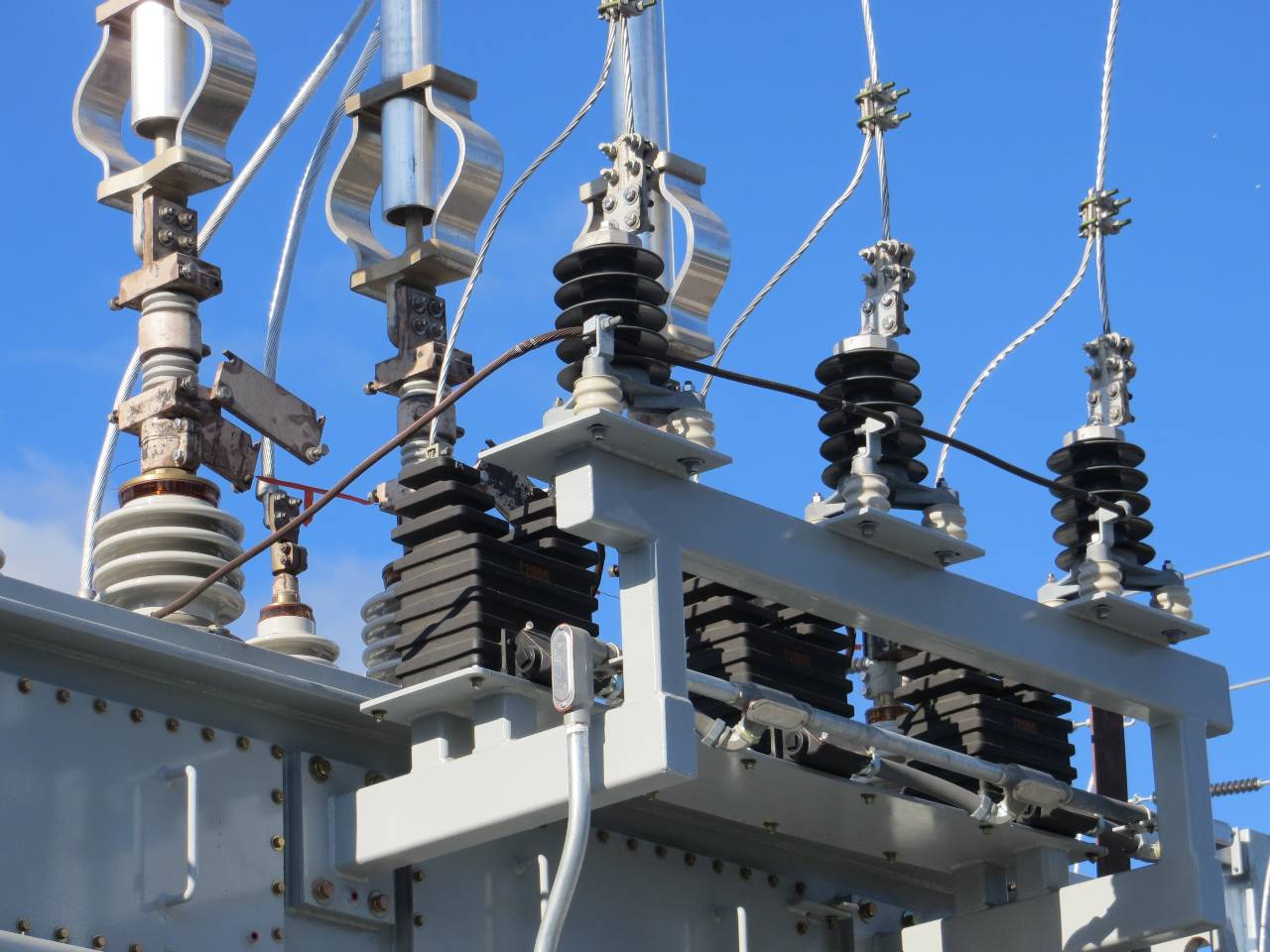
 Nyheter4 veckor sedan
Nyheter4 veckor sedanTyskland har så höga elpriser att företag inte har råd att använda elektricitet
-

 Nyheter3 veckor sedan
Nyheter3 veckor sedanOPEC+ missar produktionsmål, stöder oljepriserna
-

 Nyheter3 veckor sedan
Nyheter3 veckor sedanEtt samtal om guld, olja, fjärrvärme och förnybar energi
-

 Analys4 veckor sedan
Analys4 veckor sedanBrent crude ticks higher on tension, but market structure stays soft
-

 Analys3 veckor sedan
Analys3 veckor sedanAre Ukraine’s attacks on Russian energy infrastructure working?
-

 Nyheter2 veckor sedan
Nyheter2 veckor sedanGuld nära 4000 USD och silver 50 USD, därför kan de fortsätta stiga
-

 Nyheter3 veckor sedan
Nyheter3 veckor sedanGuldpriset uppe på nya höjder, nu 3750 USD










